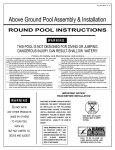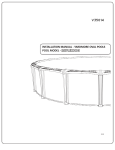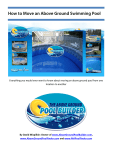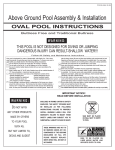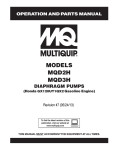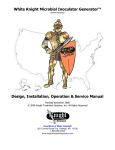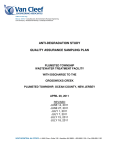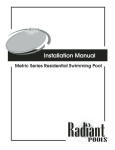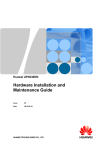Download Matrix Oval Yardmore Installation Instructions
Transcript
P/N 95-0432 03/08 MATRIX OVAL YARDMORE POOL INSTRUCTIONS Your pool is designed for years of pleasurable, safe, family fun. But, when used incorrectly, a swimming pool can be dangerous. To insure your pool is used safely you must observe the following safety precautions: Do not dive!-Do not jump!- No rough play!- No running or pushing! Do not walk on the top rail. It can be slippery and is not a walkway. Be sure to install all safety labels provided with your pool according to the instructions. Keep a safety rope 1/4” by 50’ with a flotation buoy with an outside diameter of 15”. Have accessible in a prominent area by your pool. Post near all entrances to pool area; a list of telephone numbers of the: • Nearest available police • Nearest ambulance service • Nearest available fire department • Nearest available hospital • Nearest available rescue unit • Nearest available physician • 911 emergency number if available Provide fencing or enclosure which is independent of the house as a closure around the entire pool area. The fencing must be made of durable material, a minimum of 4’ in height from ground level and with closures with self-latching locks, to make pool inaccessible to toddlers and uninvited guests. Make sure gate is always closed. Be sure to follow local building code requirements for load capacity and fencing if using an aftermarket or homebuilt deck. Check with your local town for any special laws in your locale. Never drink alcoholic beverages or use any intoxicants which could hinder your judgment and reflexes. Never use pool alone. All children must be supervised continuously. Do not use pool if bottom is not clearly visible: At night, sufficient lighting must be available. It is the pool owners sole responsibility to provide adequate lighting for pool bottom, safety signs and walkways, which exceeds minimum standards of the IES of North America. Do not climb, stand or sit on any pool structure or the filter system. Components such as the filtration system, pumps and heater must be positioned so as to prevent their being used as a means of access to the pool by young children. Be sure that all toys, chairs and tables or similar objects that a young child could climb on be at least four feet (4’) from pool. Do not use pool during electrical or rain storms. See available National Spa and Pool Institute (NSPI), publications for more tips on pool safety. IMPORTANT NOTICE! READ BEFORE INSTALLATION ENCLOSED IN FRAME CARTON IS SAFETY ENVELOPE. THE SAFETY STICKERS MUST BE INSTALLED AS PER FOLLOWING INSTRUCTIONS. FAILURE TO PROPERLY INSTALL WARNING LABELS WILL VOID WARRANTY. FAILURE TO MOUNT THESE SAFETY LABELS MAY SUBJECT YOU TO SUBSTANTIAL LIABILITY IN CASE OF INJURY. NOTICE TO POOL OWNERS AND INSTALLERS: 2 Labels for liner placement (1 supplied with liner) 2 signs: 1 for placement on outside wall next to entry to pool. 1 for placement so sign is visible from all possible entrances to pool. If more are required, write for additional signs. THESE WARNINGS ARE NOT TO BE REMOVED UNDER ANY CIRCUMSTANCES! IF THEY BECOME DISCOLORED OR FALL OFF, PLEASE REQUEST REPLACEMENTS WHICH WILL BE SENT AT NO CHARGE. PRACTICE POOL SAFETY—THESE LABELS AND YOUR COOPERATION MAY SAVE A LIFE! ALSO, FAILURE TO MOUNT THESE SAFETY LABELS USING THESE INSTRUCTIONS MAY SUBJECT YOU TO SUBSTANTIAL PERSONAL LIABILITY IN CASE OF INJURY. BEFORE INSTALLING POOL DETERMINE PLACEMENT OF LADDER. (exit and entry point to pool) LABEL LOCATIONS FOR OVAL POOLS. Label on liner Place on pool wall at entrance to pool next to ladder. (Make certain sign is firmly affixed to wall.) Put other sign on opposite side of pool. X 1 Sign X V Sign Using the two labels which are to be placed on liner above water level, locate at 2 equal points away from ladder. X WA R N I N G : Label on liner THIS POOL IS NOT DESIGNED FOR DIVING OR JUMPING. DANGEROUS INJURY CAN RESULT-SHALLOW WATER!!! Ladder YARDMORE POOL SIZES CURRENTLY NOT AVAILABLE FOR MATRIX CURRENTLY NOT AVAILABLE FOR MATRIX 18'10" 17' 25'10.5" 12' 16' 10" 17' 12 x 17 23'10.5" 12 x 24 28'6" 20'4" 26'6" 32' 15'2 20'4" 15 x 26 33' 18 x 33 2 Actual size of pool. Space needed for installation. 30' 15'2" 15 x 30 35' 23'4" 12' 42' 18'2" 23'4" 40' 18 x 40 18'2" INTRODUCTION: Congratulations on becoming the owner of a new Sharkline above ground swimming pool. This is the instruction packet for installing your swimming pool. The following are some helpful hints that you should take into consideration before installing your pool. 1) Read through the entire instruction booklet before you begin. This will enable you to find out exactly what is involved with installing your swimming pool before you begin. While you are going through the instructions, please be aware that all of the diagrams are representative of a 15' x 30'/18' x 33' pool. If you have a different size pool you will find that your pool has a different number of uprights than the ones in the diagrams. 2) DO NOT ATTEMPT INSTALLATION IN WINDY OR GUSTY WEATHER. This will not only make installation more difficult, it may result in damage to your pool before it is completely installed. 3) Although we have broken down the installation into many simple steps, you will probably find that steps one and two will be the most labor intensive and time consuming steps. Once you have completed those two steps you should find that the rest of the installation moves along much more quickly. 4) Please be sure to review all safety material and local codes before beginning your installation. There is a yellow safety envelope packed with your pool. This envelope contains safety material and warning stickers to be placed on your pool. If you are missing any of these items please contact your dealer or the factory to obtain it. The warranty is void if all safety precautions are not followed. 5) In the event that you need to make a warranty claim, it is important to know the size and model of your swimming pool in order to expedite the handling of your claim. Please fill in the information below and keep for your records. NAME OF POOL: SIZE OF POOL: DATE OF PURCHASE: NAME OF POOL WALL: NAME OF LINER: 6) Make sure you have the necessary tools and materials before beginning your installation. Below is a list of the tools and materials needed. -Shovel -Carpenters level and/or transit -Tape measure -Patio Blocks (2" x 8" x 16") -Phillips head screwdriver -Box cutter (Razor blade) -Duct tape -Tamp -Sand or pool base -5/16" wrench -Filter -1/4" wrench -Skimmer/Return fitting 3 POOL LOCATION: Do not locate pool over underground lines, septic tanks, or under electrical lines. It is essential that the area selected for your pool has a level and firm base. Do not assemble your pool on asphalt, tar, or oil base surfaces. Avoid areas with sharp objects, or ground treated with weed killer or other chemicals. Also avoid areas where nut grass, bermuda grass, or bamboo grass grow, because they can grow through your liner. Grass must be removed. Do not place components such as filters, pumps, and heaters in a way that they can be used as a means of access to the pool by young children. Be sure to follow all local building codes and obtain all building permits required for your area. STEP 1 – PREPARING THE SITE: Refer to the “true size” diagram on the second page to see the dimensions of your swimming pool. Once you have these measurements and have chosen a site to install your pool, mark or outline the ground where the pool will be going using spray paint. Please keep in mind that you will need some extra room to work. Be sure to account for the space that the side supports extend out on each side of an oval. Oval pools with the Yardmore system have a strap end channel that extends out only 19” from the wall on each side. For example, a 15x30 oval should have the following space in order to install the pool. Yardmore Oval: 32' 20'4" 30' 15'2" 15 x 30 *Once you have the appropriate area marked out, remove any sod that is in the area. Also be sure to avoid all electrical wires, gas lines, septic tanks, cesspools, dry wells, tree roots, stumps, buried debris, and sudden slopes within 6’ of the pool area. 4 STEP 2 – LEVELING: Once you have designated the space for installation including the extra space and have cleared away the sod in that area, you can begin to level the ground. The ideal tool for doing this is a transit. If you do not have access to a transit, use a long board (be sure that the board is perfectly straight) and a carpenters level, as shown in the diagram. The key to properly leveling the surface for an above ground swimming pool is to start at the lowest point and dig everything else down to that level. You do not want to build up the lower areas to be level with the higher areas. Doing this will cause the ground to settle once the pool is full of water. If the ground settles it could destroy your pool, which could be dangerous and is not covered under the warranty. You will probably not be able to get the ground completely level until you lay out the frame, but the closer you get it now the easier the job will be later. We recommend that you do not proceed until the entire site is within an inch of being perfectly level. Remove soil and grass. Remove grass only. * DO NOT ADD DIRT TO LOW AREAS. 5 STEP 3 – MATRIX PARTS BREAKDOWN: Once you have completed the ground preparation, you should open all cartons to the pool and become familiar with all of its components. You should also refer to the breakdown sheet that is packed with your pool and make sure that you have the correct number of each component necessary to complete your pool. If you are missing any parts, or you have received any damaged parts, you should notify the dealer where you purchased the pool before beginning the assembly. Curved Side Assembly Top Rail Top Cap Wall Rim Straight Side Assembly Upright Wall Rim Bottom Cuff STEP 4 – STRAIGHT SIDE TOP PLATE INSTALLATION: Now is the time to install the straight side top plates. Simply place each one over a different oval upright match the holes on the top plate to those on the oval upright and fasten them together using four #10 screws in each. Be sure that all uprights are completely vertical. If they are crooked at all there will be problems getting the top rails to fit together properly. Oval top plate drops inside oval upright & is attached on sides with 2-#10 screws #10 screw #10 screw Oval upright 6 Oval top plate STEP 5 – PRE-ASSEMBLING THE STRAIGHT SIDES OF A YARDMORE OVAL POOL: A) Start by laying out the under box channels so that the open sides of each under box channel is facing up. Then slide the strap end channel over the top of the under box channels so that they form a tube. Be sure that the holes in both channels are aligned, but do not bolt them together yet. B) Now slide the oval uprights over the strap end channels making sure that the holes line up as shown in the diagram. C) Once the oval uprights are attached, apply the left and right side gusset on each. The pieces are marked “L” and “R”. The gussets are applied under the channels and around the oval upright. Once you have them in place screw the left and right gussets to each other using three #10 screws. D) All holes should be lined up at this point. Bolt the components together as shown in the diagram. Use 5/16" x 5" yellow bolts and 5/16" nuts for the channels and 5/16" x 4 1/2" stainless steel bolts for connecting the gussets to the uprights. Remember to include the three-hole washers at the front of the gussets. E) Once all of the 5" long bolts have been tightened, install the straight side bottom connectors. This is done by placing the connector on top of the strap end channel just inside the oval upright. The hole in the connector should line up with the hole in the strap end channel. Secure the connector to the channel using a single # 12 x ¾" screw for each as shown in the diagram. *Please do not be alarmed if you are not using all of the holes in the strap end channels. We use this same channel for a few different products so there are some holes that you will not be using for this pool. You will also have 3 extra 5/16" x 4 1/2" stainless steel bolts per upright when installing the yardmore system. 4 1/2" long ss bolts 5" long bolts 7 STEP 6 – STRAP ASSEMBLY FOR YARDMORE OVAL POOLS: When you separate the strap pieces, you will find that you have two different lengths. You will have two strap components per complete strap for 12' wide oval pools, and three strap components per complete strap for all pools wider than 12'. Regardless of the size of your oval pool there is one piece of strap material that is 39.275" long for each strap assembly (example: a 15x30 pool has four strap assemblies so it comes with four 39.275" long strap pieces.) With the yardmore system that strap piece will NOT be used. You should discard these pieces so that you do not accidentally include them in your strap assembly. They are only used on a standard oval assembly. Secure the remaining strap sections to each other using two 5/16" x ½" bolts and 5/16" nuts, at each end. When they are completely assembled (as shown in the diagram) attach each end of the straps to a strap end channel using two 5/16" x ½" bolts and two 5/16" nuts at each point of connection. Note that the straps should be attached to the underside of the channels with the heads on top of the channel and the nuts on the underside. Always use the two holes closest to the end of the strap end channel when you are connecting the strap sections to the strap end channels. CURRENTLY NOT AVAILABLE FOR MATRIX 12'x17' 40.683" 41.025" 52.6875" 4 12'x24' 15'x26' 9 15'x30' 12 18’x33' 18'x40 12 18 6 * See page 2 for layout. This chart shows how many strap assemblies each pool size requires. 8 STEP 7 – STRAIGHT SIDE LAYOUT: After all of the straps have been fully assembled and attached to the strap end channels you can now start to set them up in their final positions. If your pool has an odd number of straps (for example a 12' X 24' pool has three straps) find the center point of the site you leveled earlier and put the first strap and oval upright assembly there as shown in the diagram. You then place one assembly 42", from center of strap end channel to center of strap end channel, on each side of that first assembly. Continue like this until all assemblies are used. If your pool has an even number of straps and oval upright assemblies (for example a 15' X 30' pool has four) find your center point, mark it on the ground, and put an assembly on each side of that mark 21" away to the center of the strap end channels. If your pool has more than two assemblies you will put the next assemblies 42" on center from the previous one, always keeping the same number of assemblies on each side of your center point. Once you have all assemblies in place you want to be sure that all of the oval uprights on one side line up with each other. This can be done fairly accurately by eye but we recommend that you use a string extending from the first upright to the last. If there are any uprights not touching the string, or that cause the string to bulge out, adjust that assembly so that the string is perfectly straight. If you are trying to install your pool parallel to an already existing object such as a fence, simply measure from the fence to each oval upright making sure that the measurement is exactly the same for each. Once you are confident that one side is straight the other side should already be straight. If it does not appear to be straight, check to make sure that the straps are sitting flat on the ground. Yardmore 9 STEP 8 – PRESSURE PLATE INSTALLATION: Place one 44" pressure plate on each strap end channel so that the center of the plate is even with the center of the channel. When installing these plates the corrugation bumps should be up and the flat surface should be down. One edge has a larger flat surface than the other. The larger flat surface should be closer to the center of the pool. (See diagram). The pressure plate must extend past the end of the channel about 1". If you have done this correctly the two holes in the center of the pressure plate line up with the two holes in the center of the strap end channel. Secure the plates to the channels using two #12 X ¾" screws in each. Once all plates are secured to the channels, the plates should overlap each other. Secure the plates to each other using three #12 screws in each overlapping area. Yardmore STEP 9 – BOTTOM WALL RIM: When you unpacked the bottom wall rims you should have noticed the two different size rims. Some of the rims are 37 '' and the rest of the rims are longer but the exact measurement depends on which size pool you have. It is very important to separate rims by size now. A) The 37" long bottom rims go in between the oval uprights.You simply press them down inside the straight side bottom connector on each side. These rims will eventually need to be sitting flat on the ground but you can do that as you are leveling the pool. B) You should have an even number of the longest bottom rims, as well as an even number of bottom cuffs. These will form the curved ends of your pool. Half of these rims and cuffs will go on one end and the other half on the other end. Slide each rim into cuff as shown. Be sure that the cuff is outside of the half circle created on each side of the pool. Once all rims are assembled, you should now be able to see the entire shape of the oval pool on the ground. Yardmore 10 Bottom Cuff Wall Rim STEP 10 – SQUARING THE STRAIGHT SIDES: Now that the base of the pool is fully assembled, make sure that the straight sides of the pool are perfectly in line with each other. We refer to this as squaring the pool. This is done by measuring from the outside of the first oval upright on one side, to the outside of the last oval upright on the opposite side (the two oval uprights farthest from each other.) When making these measurements they should always be taken at the lower 12" of the upright because the higher up in the upright you go the less accurate the measurements may be. Once you have that measurement you should measure the two opposite uprights the same way as shown in the diagram. The two measurements should be exactly the same. If they are not, adjust one entire side as necessary. This is a very important step, do not continue until the measurements are the same. Yardmore STEP 11 – LEVELING THE STRAIGHT SIDES: The leveling of the straight sides is a very crucial part of a good installation. If this is not done accurately it will cause a lot of problems for you. The strap end channels are two inches deep. The top of the strap end channel needs to be level with the ground. The bottom plates on the curved sides also need to be level with the ground. One at a time we recommend digging the strap end channels into the ground. Once all of the channels on a side are level, put a 2" x 8" x 16" patio block under the back of each strap end channel as shown. This must be done for each strap end channel. Remember the block is two inches deep and so is the end channel. You will need to dig down a total of 4" where the block is in order to get the top of the strap end channel to ground level. Once you have completed one entire side, do the same for every strap end channel on the opposite side. After that is complete it is a good idea to check that your oval uprights are all level from top to bottom by using a carpenters level. The pressure plates and straight side bottom rails ensure that your bottoms are still 42" on center. Be sure that the tops of the oval uprights are as well. Yardmore 11 STEP 12 – LEVELING THE CURVED SIDES: The next step is to level the curved sides of the pool. Before doing this you may want to measure the overall length and width of the pool to ensure that it is the same size as shown on page two of this booklet. If it is off by a couple of inches your wall will not fit properly. You can fix this situation by simply sliding the curved side bottom rails in or out of the bottom plates as shown. This should be done an even amount for each plate. Once you are sure that the pool is the correct size, level the curved sides of the pool. Do this by placing a 2" x 8" x 16" patio block under each of the bottom plates. The blocks will need to be sunk into the ground so that the bottom plates are at the same level as the top of the strap end channels. It is also important to make sure that the rails between the plates are resting flat on the ground. NOTE: Check for levelness in all directions. When placing patio blocks underneath curved side bottom plates, leave 1” of the block inside the pool and 4” showing outside of the pool. STEP 13 -STRAIGHT SIDE RESIN UPRIGHT INSTALLATION: Install the resin cover over the straight side assembly. Slide the resin straight side upright over the metal assembly as shown in image “A” below. Next, attach the resin upright to the top of the metal assembly with four (4) #10 screws as shown in image “B” below. Attach the bottom of the resin upright to the metal assembly with one 1/4-20 x 5" bolt and nut as shown below in figure “C”. Tighten the bolt and nut firmly. Refer to the exploded view of the straight side assembly on page #6 for an overall view of how everything fits together. A 12 B C STEP 14 – WALL INSTALLATION: *** DO NOT ATTEMPT THIS STEP IN WINDY CONDITIONS. THE WALL IS VERY HEAVY AND EXTREMELY DIFFICULT TO MANAGE ON A WINDY DAY. IF THE WIND DOES CATCH THE WALL DURING INSTALLATION IT CAN CREATE DANGEROUS SITUATIONS AND/OR CAUSE DAMAGE TO THE POOL. Before beginning the wall installation, you may remove a curved side bottom rail to cart in sand or sifted soil for the pool cove and base, as long as your curved sides are staked in position (make sure you return the bottom rim to its position.) In this step you will use the wall carton as a base to unravel the pool wall. While holding the wall joints behind an upright by starting the wall in the middle of a bottom plate, we recommend the skimmer and return hole at one of the four corners of the round section of the pool. The skimmer location is determined by where you start the wall. In any case, the wall joints must be on one of the curved ends of the pool and not on a straight side. Unravel the wall a little at a time, inserting it into the bottom rails as you go. Do not unravel the entire wall at once, for this will make installation difficult. As you unravel the wall you may temporarily install wall rims (see steps 21 & 22), or use landscaping stakes with clamps to keep the wall in place. We recommend in addition to the rails or stakes that you temporarily use, small pieces of duct tape from the wall to each of the straight side uprights as added support during the installation. If the sidewall appears too long or too short, make the curved sides larger or smaller by equally sliding the bottom rails in or out of the bottom plates. If the ground is uneven, the wall may jump out of the groove in the bottom rails. Correct this condition if it happens by rechecking the level. Yardmore X X X X X = Suggested skimmer location. 13 STEP 15: WALL JOINT ASSEMBLY: IMPORTANT- This operation must be done carefully! When joining the sidewall, make sure that the aluminum strips do not touch each other. One bar must be inside the pool (the bolts will touch this bar) and one bar must be outside the pool (the nuts will touch this bar). Insert the bolts with the bolt head to the inside and the nuts to the outside of the pool. Do not tighten until all bolts have been inserted. If your screwdriver slips and scratches the head of the bolt, file the scratch smooth so that it cannot puncture the liner. Cover the heads of the bolts, on the inside of the wall, with three layers of duct tape. If the insertion of the wall in the bottom rail is tight at the point where the wall is joined together, insert a screwdriver and twist to make enough room, again being sure not to scratch the wall or the wall rim. (Sharkline has several wall closure systems, please follow the diagram that matches your pool). Type #2 Staggered Bolt Pattern Type #1 Single Row Inside wall bar Pre-Attached inside wall bar Nut goes to outside of pool Side Wall Nut goes to outside of pool Inside of pool Side wall Inside of pool Outside wall bar Outside of pool Pre-Attached outside wall bar Outside of pool Top View Inside of pool 3/4” Bolts REMEMBER: ALL HOLES AND BOLTS MUST BE USED ON 54" POOLS! 52" AND 48" POOLS MAY HAVE A FEW LEFT OVER. ALL NUTS SHOULD BE AS TIGHT AS POSSIBLE USING HAND TOOLS. BARS MUST NOT TOUCH EACH OTHER. IF THIS IS DONE INCORRECTLY YOUR POOL WILL BREAK! Wall bar Pool wall Pool wall Wall bar 1/4” Nuts Outside of pool STEP 16 – PREPARING THE COVE: Using neutral alkalinity sifted earth or fine sand without pebbles, build a 2" base over the entire pool area to protect the liner. Make sure that the straps and the pressure plates are covered entirely. If the base does not fully cover the metal components, they will show through and will damage the liner. If using vermiculite base, you must have at least two inches of soil or sand on top of the straps and pressure plates. Vermiculite alone will not properly cover these metal components, possibly allowing damage to the liner. Do not use any substance with high alkaline or acid content, such as peat moss. It will cause the pool to corrode. Next, using sifted earth or fine sand, build a 6" to 8" pool cove inside the metal wall along the entire circumference. The cove will prevent the liner from creeping under the wall and will also protect the liner from any metal corners of the pool framework. THIS STEP IS NOT OPTIONAL – IT MUST BE DONE! Since earth containing chemicals can cause discoloration or corrosion, it is suggested that you 8” place polyethylene plastic sheeting under the cove around the perimeter of the wall, so no earth comes in contact with the metal. Since the presence of such chemicals is beyond the control of the manufacturer, such damage is not covered 2” by the warranty. The plastic sheeting will not prevent a 8” washout in the event that your liner is damaged. The plastic is only to protect the metal framework of the pool from corrosion. 14 STEP 17 – UPRIGHT INSTALLATION: Install upright by simply lining the upright up to the three clips in the bottom of the cuff and pushing down until all three clips lock in. Once this is done correctly the upright should not pull up without bringing the bottom cuff and wall rims with it. Do this around the entire pool. When all uprights are attached check the pool for dimensions again, making sure the measurements are correct in all directions. Upright Bottom Cuff Wall Rim Yardmore * Wall joint is hidden behind the upright. This assures that the skimmer and the skimmer return holes are not obstructed 15 STEP 18 – LINER PREPARATION: After cove and base are in place, tamp and rake the entire pool area. Make sure that no sand remains on the wall above the coving. This may cause pinholes in your liner. Before installing the liner, punch out skimmer and skimmer return holes if necessary, using a hammer and a screwdriver. Duct tape or silicone the raw edges of the metal at the skimmer and return cutouts to protect from sharp edges. Locate your safety envelope, take out the double-sided vinyl gasket and install skimmer return gaskets as shown on included instruction sheet. THIS MUST BE DONE! You must also periodically inspect the gaskets for leaks to validate warranty. This is a critical step in pool maintenance. The majority of pool problems that we have seen over the past 40 years have been a result of poor skimmer and return gasket maintenance. If you see these areas leaking they MUST be repaired. Skimmer gasket Separate flaps Return outlet gasket Gasket Remove Screw holes (punch out) Wall Side view installed Skimmer Gasket Trim off approx 1/2" Remove Return outlet gasket *See additional instructions included in your safety envelope 16 STEP 19 – HANGING LINER AND COPING INSTALLATION: *** FOR OVERLAP LINERS ONLY! IF YOU HAVE A BEADED OR A J-HOOK LINER SEE SEPARATE INSTRUCTIONS WITH LINER. Starting at the liner wall seam, hang the liner over the wall, making sure that the seam is straight up and down, perpendicular to the floor. This will assure you that the liner begins going over the wall straight. If you have a border print liner simply pick a mark and hold it all the way around the pool. As you put the liner over the wall you can secure it using plastic coping. If you end up with excess material continue around the pool pulling excess liner evenly, and distribute over the wall until the excess is gone. Liner overlapping pool wall Plastic coping installed at this time to hold liner in place Pool wall cove cove CORRECT LINER SEAM Resting evenly on the cove of the pool. INCORRECT LINER SEAM Shifted up wall. This should not be done. Correct this situation if it occurs. Make sure seams of liner are parallel with the pool wall to ensure that liner is straight. *NOTE: Line wall seam straight up and down, away from skimmer and skimmer return. 17 STEP 20 – LINER ADJUSTMENT: (FOR OVERLAP LINERS ONLY) * Check which kind of liner you have with your pool before continuing with these instructions. Once the liner is held securely in place by coping, temporarily pull wrinkles in the floor towards the side wall evenly, leaving the wrinkles at the cove. When the liner is correctly positioned, there must be no air space between the liner and the ground or side wall. Remove wrinkles at the cove by adjusting the amount of material over the wall. Do not pull too tight – leave the slack on the sides. When a liner is properly installed, there is no downward pressure on the liner. The liner will pull in if the wall vinyl does not have some slack when installing the pool. Start filling the pool. When the water is no more than one inch deep, check to see that it is still level. If the water runs to one side, remove the coping a few pieces at a time, pull back the liner and make the ground level. When level, continue to fill and adjust the liner. Do not cut the skimmer and skimmer return holes in the liner until fully adjusted and the pool is 1/3 filled. CORRECT INCORRECT! No air space between liner and pool slack on sides. Do not leave a gap between liner and cove. This will cause downward pressure on the liner. Correct this condition if it occurs. BEADED LINER J-HOOK LINER Coping Bead Receiver Coping Bead Receiver Wall Rim (supplied with pool) Wall Rim (supplied with pool) J-Hook Liner Beaded Liner Pool Wall Pool Wall Pool Water 18 Pool Water * These are two other common types of liners for above ground swimming pools. If you have one of these types of liners, please ignore this step and refer to separate instructions provided with your liner. STEP 21 – TOP WALL RIM INSTALLATION: Detail When you are completely satisfied with the way that your liner is hanging, you can now permanently install the other half of your wall rims on the top of the pool, as shown in the diagrams. This is done by snapping one side of the wall rim into the clip on the top portion of the upright, inserting the wall into the slot in the wall rim, then snapping the other side of the wall rim into the clip on the top portion of the next upright over, and applying downward pressure with your hands until the rim is securely fastened over the coping that is holding your liner (note: if you have a J-Hook liner there is no coping so the wall rim will go directly over the bead of the liner). Continue this around the entire pool. Wall Rim (Installed before top rail pivots down.) Top Rail (Only shown in this step as a guide. See step 24 for procedure to install.) Wall Rim Upright 19 STEP 22 – TOP WALL RIM INSTALLATION: Lay-Out When the liner is completely adjusted and the plastic coping is secured (if an overlap liner) the next step is to install the wall rims. You should have 4 different size rims /spacers. See the diagram below for the location of each size. A) 11" long wall rim spacers for each curved side upright. This spacer fits over the wall, just under the top lip of the upright. B) 13" long wall rim spacers for each straight side upright. This spacer fits over the wall, just under the top lip of the upright. C) 38 1/6" long wall rims that go between each straight side upright. They also go from each straight side upright to the 1st curved upright at the four “corners” of the oval. The rim fits over the wall and fastens to the upright. See Step 21 diagram. D) 49" (15' oval) or 50" (18' oval) long wall rims that go between each curved side upright. The rim fits over the wall and fastens to the upright. See Step 21 diagram. Yardmore D. Curved Side Rim A. 11" Rim Spacer C. 38" Straight Side Rim B. 13" Rim Spacer Coping Liner 20 STEP 23 – TOP RAIL ASSEMBLY: After all of the wall rims around the entire pool are on, you can now assemble the top rails. To do this: A) Slide each of the top rails down into the corresponding opening in the top of the upright as shown in the diagram. B) Once both sides of the top rail are in, push the front of the top rail (the side that will be inside of the pool) down into place. At this point the holes in the top rail should fit around the raised circles in the uprights. C) Now insert a lockdown fastener into each side of the top rail and down into the upright. Turn them 90 degrees clockwise. D) Repeat steps A through C until at each upright there are two lockdown fasteners in place. A Top Rail B Upright C Lock Down Fastener Upright STEP 24– TOP RAIL INSTALLATION: You should have two different size top rails with your oval pool. The short top rails (measured from longest point to longest point) are for the straight sides of the pool. Yardmore Once all of the straight side rails are done, install the longer rails on the curved sides in the same fashion. 21 STEP 25 – INSTALLING THE TOP CAPS: Center a top cap on each upright one at a time. Angle the front of the cap (the wider half of the cap which goes to the inside of the pool) down towards the floor of the pool and clip it to the inside of the upright. Pull down and back until the cap clips onto the back (or outside) of the upright. The top cap should now be secure and flush with the top rails. If it is not, pull the cap off and try again. The caps should fit on easily and should not require excessive force to snap into place. Continue around the entire pool until the joint at each upright is covered. Once that is done the installation of your Matrix resin pool is complete. Be sure to remove all stakes that were holding the bottom ring at this time, if you have not already done so. Congratulations and enjoy your pool safely! Top Cover Top Rail Upright 22 FINAL INSTALLATION TIPS: When installing a thru-the-wall skimmer, follow the instructions of the manufacturer. It is essential that there is no leakage of water at either of the openings. If water is allowed to drip down the metal wall of the pool, it will cause the wall to eventually deteriorate and split. At the slightest sign of corrosion, you must sand down this area and paint it. It is a good idea to silicone the edge of the wall at skimmer opening. A special double sided vinyl gasket is included that is to be used beneath vinyl liner at skimmer opening. Gasket is used directly over steel and aluminum wall. Be prepared to chlorinate your water within 24 hours of filling to prevent algae and bacterial growth. If you are using well water or water with high mineral content, consult your pool dealer for proper preventative action. DO NOT PUT POOL CHEMICALS DIRECTLY INTO THE WATER. ALL CHEMICALS MUST BE THOROUGHLY DISSOLVED IN WATER, AND THEN POURED INTO POOL. IF CHLORINE IS NOT DISSOLVED, IT WILL BLEACH LINER AND MAKE PINHOLES IN THE LINER. IF WATER IS DRAINED AT ANY TIME, LINER MAY SHRINK AND BECOME UNUSABLE WITH NO RECOURSE TOWARDS THIS COMPANY. REMOVAL OF WATER WILL VOID WARRANTY. POOL MAINTENANCE: Small repairs and punctures in your liner may be easily repaired using underwater repair kits available at your local dealer. Scratches on your pool wall and frame must be touched up with anti-rust enamel paint. Keep your pool wall and frame clean. Wash periodically with a mild soap solution (no abrasives) Use a clear non-yellowing household wax on all metal components. Quickly wash away any deposits of pool chemicals which land on the frame of your pool. Since metal parts are subject to wear and/or corrosion a strict periodic inspection schedule should be maintained and followed. If any corrosion is found IMMEDIATE CORRECTIVE ACTION MUST BE TAKEN. Wire brush all rust and add a coat of enamel primer followed by a coat of color matching anti-rust enamel paint. The skimmer area is one particular area that must be carefully inspected. If any corrosion is allowed to continue, failure of the pool structure may follow which could result in excessive property damage as well as bodily harm. WINTERIZING YOUR POOL: All of our liners are designed to be left up all winter, but nonetheless are subject to the warranty of the liner being purchased. Continue to chlorinate and filter until the pool is closed down. Before closing down your pool for the winter you must make a complete inspection of the pool. Check all the connections to make sure everything is tight and in good condition. Check to see that the liner is snugly held in place over the wall. If there is any indication of rust or deterioration in any part you must correct the situation immediately. During the winter the pool is subject to more stress than in the summer and any breakage that is caused by incorrect winter procedures is not subject to any warranty with this company. Lower the level of water to about one foot below the skimmer holes. Throughout the winter you must continually check this level as it must not reach the skimmer holes at any time during the winter. Because of rain and snow, adjustments will become necessary. If you live in a climate where temperatures below zero are common, you must be more careful in protecting your pool against ice expansion. You must not allow the ice or water level to rise during the winter. Use an extra ice equalizer or two as an extra precaution. Never leave the pool stand empty without any water in it as it will be subject to wind damage. If ice is allowed to reach the skimmer holes any movement can cause damage to wall at this point. During the winter the pool requires the use of an equalizer to allow for the expansion and contraction that occurs when ice is formed and to hold cover up. This can be a product manufactured for this express purpose and is available at your local swimming pool dealer. The use of a winterizing agent will simplify the start-up of the pool next season. A cover designed for winter use is also recommended to keep the dirt out. If your skimmer is supplied with a winter plate and cap, follow same steps as above. It is essential that no water be allowed to run down the wall for any period of time as it will cause the wall to deteriorate. If your skimmer did not come with the winter plate it is available at a nominal charge at your dealer and is recommended. Even in the summer the SKIMMER MUST NOT BE ALLOWED TO LEAK INSIDE OR OUTSIDE THE WALL as this will cause the wall to deteriorate and possibly break. YOU HAVE BEEN GIVEN TWO WARNING LABELS WHICH MUST BE PLACED ON THE LINER EQUALLY DISTANT. ONE LABEL HAS ALREADY BEEN ATTACHED TO THE TOP RAIL. THE ENVELOPE YOU HAVE RECEIVED GIVES FULL INSTRUCTIONS. YOU HAVE ALSO RECEIVED A LARGER SIGN WHICH IS TO BE PLACED ON THE OUTSIDE WALL NEXT TO THE ENTRY OF THE POOL. 23 IMPORTANT WINTER RULES: After pool has been winterized and ALL steps carefully followed, the following checks and procedures MUST BE strictly followed during fall, winter and spring seasons. YOUR POOL WARRANTY WILL BE INVALID IF POOL HAS BEEN IMPROPERLY WINTERIZED AND THE FOLLOWING PROCEDURES NOT STRICTLY ADHERED TO. POOLS WHICH HAVE BEEN INCORRECTLY WINTERIZED HAVE BEEN KNOWN TO COLLAPSE UNDER THE TREMENDOUS PRESSURES EXERTED BY ICE AND SNOW. A pool that is left up during the freezing temperatures MUST NOT BE ALLOWED TO LEAK. To determine if your pool is leaking, mark the liner at the water level and very closely observe the water level in the pool for a period of 10 days to 2 weeks after pool is closed for the season. Any rain during this period may compensate for any undetected water leakage. Therefore, observation period must be extended to find any leaks. All leaks must be found and immediately repaired. Any water leakage which goes undetected or occurs after top surface is frozen will allow the frozen surface to settle and may damage the pool liner, wall and framework. NOTE: It is not uncommon for a leak to develop during rigorous summer usage and go undetected. What is thought to be water loss due to evaporation or spillage may be caused by a small leak. Persistent wet areas around pool should be inspected. Maintain a strict leak inspection schedule throughout the fall, winter and spring months. Spring thawing which frequently leads to ground heaving can be especially dangerous if care is not taken. Maintain a strict inspection of the in wall skimmer housing to see that water is not leaking at the gasket. If the skimmer was not removed water should not be allowed to build up in the skimmer housing as the water will freeze and crack the housing and cause possible damage to the wall. Should ice cut your pool liner thereby allowing the pool to empty, remove all weight from the top of your pool cover, otherwise the pool could collapse due to the pulling in of the cover. Consult your pool dealer for the proper winter chemicals for quick spring start up. A winter cover is recommended for winter use, to keep pressure on the equalizer so it is forced into the water and to keep the pool clean. During the course of the winter the liner may pull out of its coping due to no fault of the MANUFACTURER OR THE POOL INSTALLER. Due to freezing and thawing of the ground, the ground sometimes sinks and the liner with the weight of ice or water will sink also, thusly pulling the liner out of its coping. DO NOT PERMIT ICE SKATING, as this may damage the liner. IF THESE INSTRUCTIONS ARE NOT FOLLOWED CAREFULLY YOUR WARRANTY WILL BE VOIDED WITH POSSIBLE PERMANENT DAMAGE TO YOUR POOL. WHEN USING A WINTER POOL COVER The illustrations below demonstrate the correct way to install your winter cover. The illustration on right marked incorrect is a very common mistake that may possibly cause damage to your pool during the winter months. 24
























